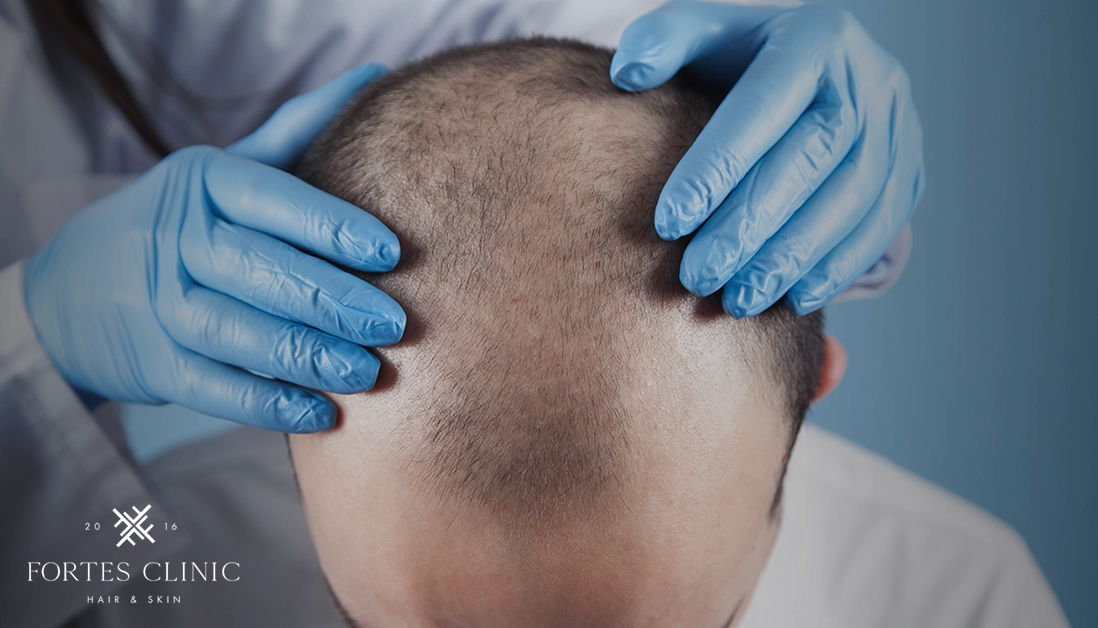Introduction
A receding hairline is a common concern, affecting both men and women, and often begins as early as the twenties or thirties. Many patients at Fortes Clinic ask whether a hair transplant receding hairline procedure can effectively restore their hair and confidence. This article explores causes, treatment options, techniques, recovery, long-term expectations, and real patient considerations to help you make an informed decision.
What Causes a Receding Hairline?
Genetics is the main cause of receding hairlines, driven by the effects of the hormone DHT (dihydrotestosterone), which weakens hair follicles over time. Other causes include stress, poor nutrition, medical conditions such as thyroid disorders, and certain medications. Lifestyle factors like smoking and high alcohol intake can also accelerate hair loss. Early consultation with a hair restoration specialist can identify these factors and help plan the best intervention strategy.
Is a Hair Transplant Receding Hairline Treatment Effective?
Hair transplant receding hairline procedures are proven to create natural results when performed by experienced surgeons. Patients at Fortes Clinic often ask if a hair transplant receding hairline treatment can match their existing hair and look age-appropriate. The answer is yes, when planned with skill and care.
How Do Hair Transplants Improve Hairlines?
Hair transplants relocate healthy hair follicles from donor areas, usually the back or sides of the scalp, to thinning or receding areas. This ensures natural growth because transplanted hair retains its genetic resistance to DHT.
At Fortes Clinic, hairline restoration is tailored to each patient. Surgeons analyse facial structure, age, future hair loss patterns, and desired density to create a balanced, age-appropriate hairline. You can learn more about how hair transplants work here.
Designing a Natural Hairline
Creating a natural hairline requires both technical skill and artistic understanding. Surgeons consider hair direction, angle, and density placement to mimic natural growth while preventing overcrowding. Temple reconstruction ensures facial balance, while matching hair calibre and texture helps blend transplanted hair seamlessly with existing strands. This design process ensures results that not only look natural but also age gracefully with the patient.
Common Questions from Patients
Many patients ask if a hair transplant receding hairline procedure will last long-term and look natural as they age. It is important to remember that transplanted hair behaves like the hair in the donor area. If your donor hair is strong, thick, and unaffected by pattern baldness, the results will remain consistent for decades. However, patients should be aware that natural ageing and hormonal changes can continue to affect non-transplanted hair, leading to further thinning over time. This does not affect the transplanted follicles themselves but may require future touch-up sessions to maintain density. For more details, read how long a hair transplant lasts.
Lifestyle Considerations for Longevity
Maintaining transplanted hair also involves simple lifestyle adjustments. A balanced diet rich in vitamins such as biotin and zinc promotes hair health. Avoiding smoking, which restricts blood flow to the scalp, and managing stress can reduce hair shedding. Regular scalp massages can also stimulate circulation and support healthy growth. Fortes Clinic specialists will guide patients on post-surgery care, shampoo routines, and long-term hair health strategies to maximise results.
Combining Treatments for Optimal Results
Some patients achieve the best aesthetic outcome by combining a hair transplant with other treatments such as PRP therapy or medications like Finasteride. PRP therapy involves using the patient’s blood plasma to nourish and rejuvenate hair follicles, encouraging thicker and stronger growth. These combined approaches support both transplanted and existing hair for a fuller, more natural hairline.
When to Consider Surgery
Timing is crucial for hair transplant success. Patients are generally advised to undergo surgery once their hair loss pattern has stabilised. Performing a transplant too early, when hair loss is active, can lead to unnatural results if surrounding hair continues to thin. During consultation, Fortes Clinic’s surgeons assess progression and recommend the best timeline for each individual to achieve lasting satisfaction.
Recovery Timeline and Aftercare
Recovery is often faster than patients expect. Most experience redness and slight swelling within the first week. Scabs form where follicles were implanted and naturally shed within ten days. It is vital to follow aftercare instructions to protect new grafts and ensure optimal results. Patients are advised to sleep with their head elevated, avoid touching the scalp unnecessarily, and use only prescribed shampoo. Within a month, hair enters a resting phase and sheds, a normal process before regrowth begins at around three to four months post-surgery. Over the next year, transplanted hair thickens and matures, blending seamlessly with surrounding strands. For an overview, see hair transplant recovery week by week.
Long-Term Maintenance and Follow-Up
Patients often ask about the long-term maintenance required after a hair transplant. It is essential to attend regular follow-up appointments to monitor hair health and ensure the transplanted follicles are thriving. Surgeons may recommend annual reviews to check progress and suggest supplementary treatments if needed.
The Psychological Impact of Restored Hairlines
Hair transplants not only improve physical appearance but also have a significant impact on mental well-being. Many patients report feeling more confident in social and professional situations. Improved self-esteem can enhance overall quality of life and reduce anxiety related to appearance.
Choosing the Right Clinic
Selecting the right clinic for your procedure is crucial. Ensure the clinic has experienced surgeons, a portfolio of successful hairline restoration cases, and positive patient testimonials. At Fortes Clinic, the team prioritises safety, natural-looking results, and ongoing support for every patient.
Contact Fortes Clinic
If you are considering a hair transplant receding hairline procedure or would like personalised advice on restoring your hairline, contact Fortes Clinic today to book your consultation.
Additional Considerations and Final Thoughts
It is also important to consider emotional preparation before undergoing a hair transplant. Feeling informed and ready for the journey ahead helps patients remain positive during the recovery process. Attending consultations with questions written down, understanding realistic expectations, and discussing lifestyle adjustments can enhance results and confidence.
Overall, a hair transplant receding hairline treatment remains the most effective way to restore a natural-looking hairline permanently. To explore your options and restore your hairline with confidence, contact Fortes Clinic today to book a consultation.



